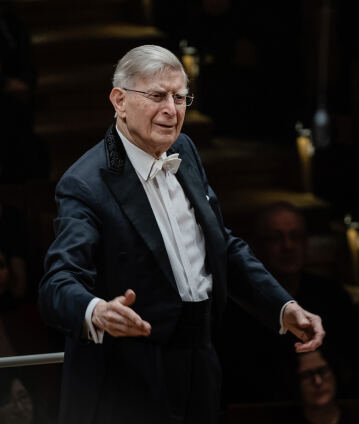Herbert Blomstedt and Leif Ove Andsnes

A medieval city, a knight on horseback, and the sound of the forest were atmospheric inner images that inspired Anton Bruckner to create his mysteriously luminous Fourth Symphony. The conductor of this performance is Herbert Blomstedt, one of the foremost interpreters of Bruckner. In Mozart’s Piano Concerto No. 22 – which audibly picks up on the soundscape of the opera Le nozze di Figaro which he wrote at the same time – we also hear Leif Ove Andsnes, the Berliner Philharmoniker’s Pianist in Residence for 2010/11.
Anton Bruckner repeatedly called his Fourth Symphony, which he composed in 1874 and subjected to radical revisions through 1880, “romantic”. The composer elucidated what he meant by that ten years after giving the work the form that is now considered final: “In the romantic 4th symphony, in the 1st movement the intention is to depict the horn that proclaims the day from the town hall. Then the town comes to life; in the Gesangsperiode, the theme is the song of the bird, the great tit Zizipe. [...]. 2nd movement: song, prayer, serenade. 3rd hunt and in the Trio how a barrel-organ plays during the midday meal in the forest.” According to other sources, Bruckner was imagining a “medieval city” at “dawn” and “forest murmurs” during the composition of the first movement, and while working on the second movement, in contrast, a “boy in love” and his unsuccessful attempt to “climb through his sweetheart’s window”, and a folk festival in the Finale. Numerous other examples of Bruckner’s attempts at pictorial descriptions of his music can easily be found. But it is remarkable that he failed to come up with a definitive “programme” for the Fourth Symphony. And the composition’s standardised, four-movement sequence makes it quite clear that Bruckner was orienting himself more towards classical models than towards works of so-called “programme music”.
With Herbert Blomstedt, not only is one of the Berlin Philharmonic’s long-standing artistic partners taking on Bruckner’s Fourth Symphony, but also a conductor who has already repeatedly demonstrated his profound understanding for the music of this composer by conducting memorable concerts, especially in Berlin.
On the first half of the concert, the orchestra will once again encounter the Pianist in Residence from the 2010/11 season: Leif Ove Andsnes. The Norwegian pianist, to whose interpretations the New York Times once attested “magisterial elegance, power and insight”, will put his view of Wolfgang Amadeus Mozart’s Piano Concerto in E flat major, K. 482, composed in Vienna in 1785, up for discussion. The work is considered one of Mozart’s so-called “symphonic” piano concertos, in which at the peak of his Viennese heyday the composer struck out on new forward-looking paths of orchestral handling. That Mozart composed the E flat major concerto in close proximity to his work on the opera Le nozze di Figaro can be detected quite clearly in the prevailing cheery mood, giving way to a gentle melancholy only in the variations of the slow middle movement.
© 2020 Berlin Phil Media GmbH
Related interviews
Artists
Our recommendations
- Herbert Blomstedt and Leif Ove Andsnes
- Bernard Haitink and Leif Ove Andsnes perform Brahms’s Second Piano Concerto
- Andrés Orozco-Estrada and Leif Ove Andsnes
- Herbert Blomstedt conducts Schubert and Beethoven
- Herbert Blomstedt conducts Bruckner’s Eighth Symphony
- Herbert Blomstedt conducts Beethoven’s “Eroica”